Spring is a big and busy time around here: I pull up old plants, rake over beds, amend the soil, sow rows of seeds, and watch over seedlings. For most of March and April, I’m constantly dealing with dirt under my nails and mud stuck to my Bogs. (Hence, you will almost always see me in pictures with a manicure, as the polish helps hide unsightly nails. It sounds strange, but I’d go crazy if I could see how they actually looked after I’d just repotted a hundred plants.)
One task I happily hand over to my husband, however, is managing our main compost heap. We have a few compost heaps going on all over the yard, all year long, from our vermicompost to our chicken manure to our leaf mold to our tumbler (plus a few piles of dead plants we pull up every season).
The tumbler is where we add our wood ash and kitchen scraps, and twice a year we dump it all out and collect all the compost it’s created.
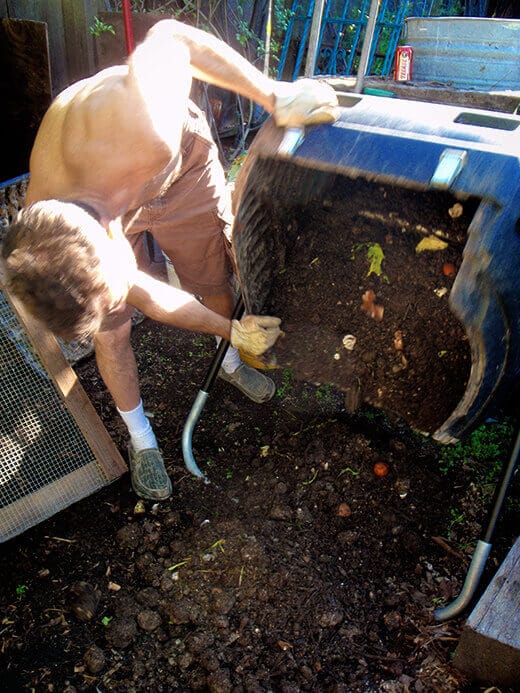
Most of the time, we get a heap of fine, crumbly, beautiful black earth that’s ready for the garden. But other times, there are still bits of moldy oranges or rotting squash buried in the mix, not fully digested yet. Maybe we’ll even find a few twigs or rocks in there.
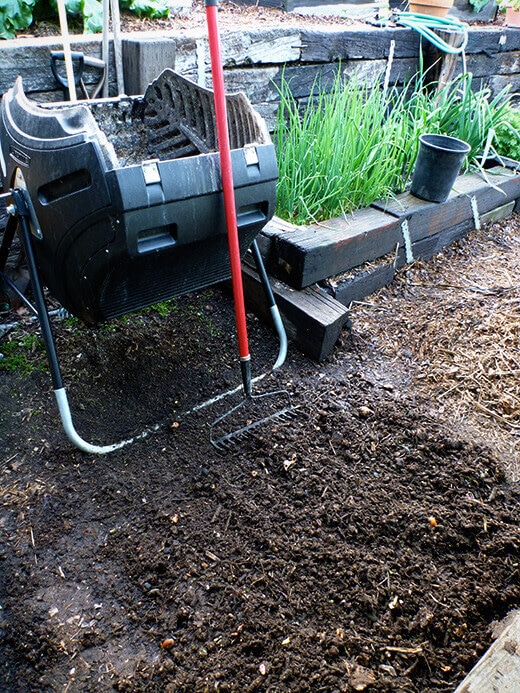
While it’s not always necessary to sift your compost before spreading it in the garden, it makes a better planting medium without all those lumps and clumps, and also makes sure that only finished compost goes into the soil. Sifting also aerates the compost, improving the soil structure of your garden beds.
To sift our compost, we made a sifting screen out of three 2x4s and a sheet of 1/2-inch hardware cloth stapled to the frame. The reason we have a three-sided frame (instead of a more common four-sided frame) is for ease of use with a shovel.
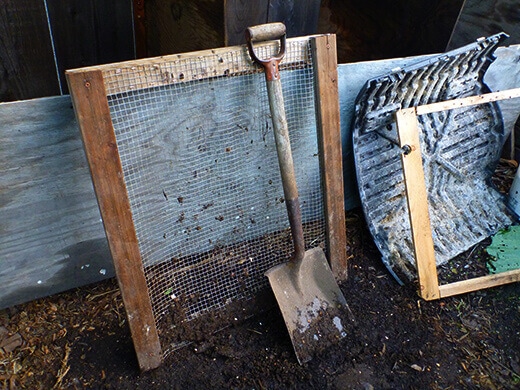
We (and by we, I really mean he − the hubs) prop the screen up at a 45° angle, shovel a layer of compost over the screen, then use the flat end of the shovel to “grate” the compost against the hardware cloth. Finished compost falls through the screen, while unfinished compost falls back to the ground.
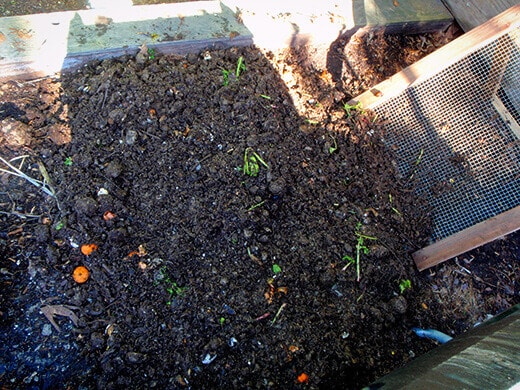
When all is sifted and done, the finished compost is shoveled into a separate bin for future use, while the unfinished compost is put back in the tumbler as a starter for next season’s scraps.
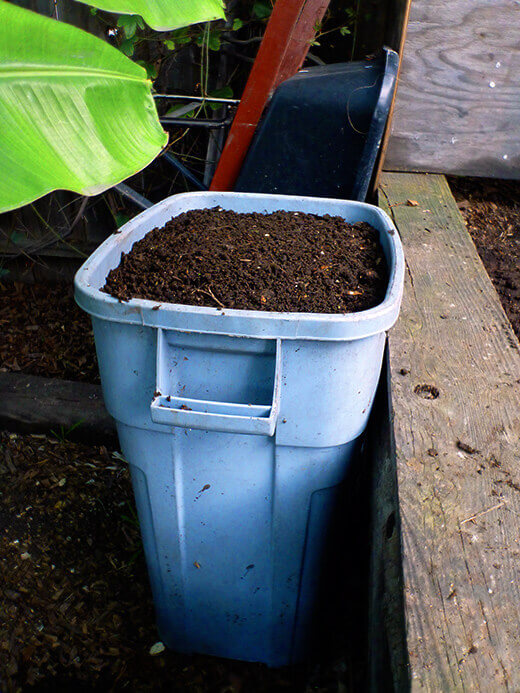
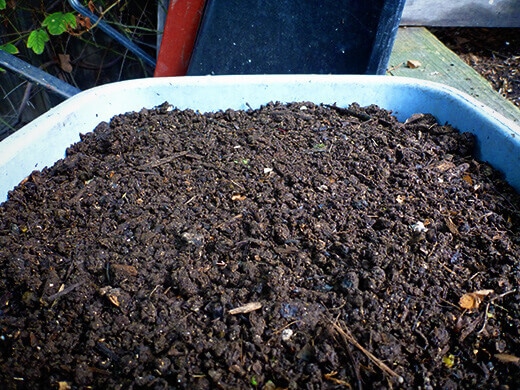
From the tumbler alone, we usually fill a large trash bin with enough compost to amend a couple of raised beds. The compost is heaped onto the soil as a top layer several inches thick, thoroughly watered in, and left to rest for a few days before we start planting.
Next week, we’ll tackle the composted chicken manure. What are your garden chores this spring?


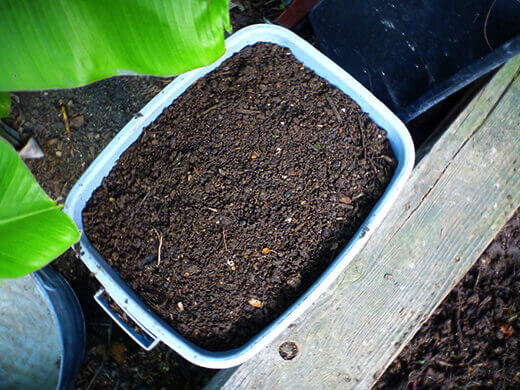













Hi, you said you prepare your compost to use twice a year? I am a first time composter & I am wondering other than spring, when do you add compost to the garden? Also what do you do over winter? I could easily continue adding food scraps to my bin, but adding brown material could be a little more challenging.
I also add compost when I rework the garden beds for fall planting. Summer crops like tomatoes and squash are heavy feeders, so the soil needs a good boost of nutrients before cool-weather crops go in. To keep your compost pile going through winter, try to save a good supply of dead fallen leaves and sticks in the fall, shred/chip them, and add them to your greens as needed to balance it out.
I was curious about the size of your composting tumbler. I am looking into purchasing one to finally try my hand at composting and am wondering whether to invest in a 33 or 70 gallon capacity one. It’s a $100 difference so I’m thinking the bigger one would be better (I’m looking at the Jora dual compartment tumbler). My household is only 2 people, but I cook almost every meal from scratch so we have a decent amount of waste. What might you recommend? Thank you!
I think I have a 50-gallon tumbler, but I also have a few freestanding compost heaps. If you generate a lot of kitchen scraps and you don’t have any other compost in the yard, then I think you’ll have no trouble filling the 70-gallon tumbler over a whole season. Keep in mind that you’ll be mixing your scraps with brown material, and you’ll also be leaving some space inside the tumbler to allow the contents to roll around.
Thanks so much! I greatly appreciate your advice. I still have a lot to learn about composting – any future blog posts in this area would be very welcome! Thank you again.
Having a tumbler actually makes it pretty easy since you don’t have to manually turn a pile or maintain the proper temperature. Just remember to keep a roughly 50/50 ratio of green to brown materials (kitchen scraps and lawn clippings count as green, while things like dried leaves and shredded paper count as brown) and make sure your compost stays moist, but not wet. Good luck!
Just found your blog – thrilled to be here. LOL on the compost-sifting. Just did that today. I’m fat and needed the exercise so I did it myself. Exhausting – but the results are gorgeous!
LOL!
Thanks for the mention! RT @WormFactory: Spring planting with sifted compost from @theGardenBetty: http://t.co/7X4vISHQXf #gardenchat
What wood ash and kitchen scraps look like after 6 months: It’s Spring… and Time to Sift the Compost http://t.co/XTqzgVndc7 #gardenchat
RT @theGardenBetty: Use a sifting screen to get the best compost. It’s Spring… and Time to Sift the Compost http://t.co/qmXbdBgnKX #ga …
Use a sifting screen to get the best compost. It’s Spring… and Time to Sift the Compost http://t.co/qmXbdBgnKX #gardenchat #gardening
Spring is a big busy time around here! What’s on your garden to-do list? It’s Spring… and Time to Sift the Compost http://t.co/vZuAEGFT1X
Working our DIY compost sifting screen: It’s Spring… and Time to Sift the Compost http://t.co/ska9ak19xm #gardenchat #gardening
Larry Peitersen liked this on Facebook.
Amy Goo liked this on Facebook.
RT @theGardenBetty: Sifting compost produces that fine, crumbly, beautiful black earth. It’s Spring… and Time to Sift the Compost http …
Sifting compost produces that fine, crumbly, beautiful black earth. It’s Spring… and Time to Sift the Compost http://t.co/nPiN7NIb9f
I love the end result too! It’s so satisfying to open up a bin of finished compost and smell all that fresh earth.
Justine Law liked this on Facebook.
Autumn here in Australia and I’m doing similar things! Garlic is just about to go into every inch of garden that gets winter sun. Just posted last week about similar topic on my blog too! (complete with photo of finished compost 🙂 I love the end result of composting-despite only having a small space in the inner city and using a two bin system. Love reading about your Californian adventures -thanks for the inspiration from across the seas!
http://domestica.com.au/
Autumn down in the southern part of the world and am doing the same thing!
I actually wish we had more of a winter, it’s been very dry here! Only one day of rain all month.
It’s Spring… and Time to Sift the Compost http://t.co/BSy7ZUZloz #springgarden #gardeingtips
What are your garden chores this season? It’s Spring… and Time to Sift the Compost http://t.co/x4260ukYYn #gardenchat #gardening
Beautiful! Your pictures make me very excited about composting … probably more than I would be otherwise. I don’t have an operation big enough for serious composting, although I have thought about getting a vermicomposter. I know one of the benefits of a tumbler is that you can get finished compost pretty quickly, just a few weeks. Do you typically use your compost pretty quickly? If not, how do you recommend storing it?
A vermicomposter is definitely useful for small spaces like patios or garages, but a tumbler doesn’t take up much space either. It’s something you can just put in a side yard, since it doesn’t require open ground for composting. The benefit of a tumbler is that it heats up your compost pretty quickly. I haven’t heard of compost finishing in just a few weeks though… maybe it’s possible if you put a compost activator in with your scraps, and chop up all your scraps very finely.
I use all my compost in the spring and fall, but over a period of a few weeks. It’s stored in trash bins and 5-gallon buckets… whatever’s cheap and handy!
I found that info from a few sources–books and bloggers mostly. You do have to chop pretty small, but it has something to do with turning the compost at peak heat, which is probably too complicated an operation for me, haha. I did end up getting some worms, though!
Ha, I know what you mean about the compost bin and it’s what makes me want to get a tumbler like yours for easier emptying! I usually just shovel it all, unfinished, into my beds fairly early, then cover them up with old coffee bags or cardboard and let it “sleep” for a bit longer, so that by the time it’s planting season it’s black gold right in the beds 🙂
I was just recommending to a friend recently that since she doesn’t garden over the winter, she should compost all her scraps “in place” in her raised bed so that it’ll be ready by spring!
Spring planting with sifted compost from @theGardenBetty: http://t.co/7vXi0b6VZX #gardenchat
Luann Watson liked this on Facebook.
Allison Lynch liked this on Facebook.
Not spring here very wintery
Diana Heffernan-Schrader liked this on Facebook.
Christopher Stinnette liked this on Facebook.
It’s Spring… and Time to Sift the Compost:
Spring is a big and busy time around here: I pull up old plants, r… http://t.co/A93Oibk2RT
Blogged on Garden Betty: It’s Spring… and Time to Sift the Compost http://t.co/zgA3PnFsaU